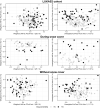Associations between dog keeping and indoor dust microbiota
- PMID: 33674692
- PMCID: PMC7935950
- DOI: 10.1038/s41598-021-84790-w
Associations between dog keeping and indoor dust microbiota
Abstract
Living with dogs appears to protect against allergic diseases and airway infections, an effect possibly linked with immunomodulation by microbial exposures associated with dogs. The aim of this study was to characterize the influence of dog ownership on house dust microbiota composition. The bacterial and fungal microbiota was characterized with Illumina MiSeq sequencing from floor dust samples collected from homes in a Finnish rural-suburban (LUKAS2, N = 182) birth cohort, and the results were replicated in a German urban (LISA, N = 284) birth cohort. Human associated bacteria variable was created by summing up the relative abundances of five bacterial taxa. Bacterial richness, Shannon index and the relative abundances of seven bacterial genera, mostly within the phyla Proteobacteria and Firmicutes, were significantly higher in the dog than in the non-dog homes, whereas the relative abundance of human associated bacteria was lower. The results were largely replicated in LISA. Fungal microbiota richness and abundance of Leucosporidiella genus were higher in dog homes in LUKAS2 and the latter association replicated in LISA. Our study confirms that dog ownership is reproducibly associated with increased bacterial richness and diversity in house dust and identifies specific dog ownership-associated genera. Dogs appeared to have more limited influence on the fungal than bacterial indoor microbiota.
Conflict of interest statement
The authors declare no competing interests.
Figures




References
Publication types
MeSH terms
Substances
LinkOut - more resources
Full Text Sources
Other Literature Sources

